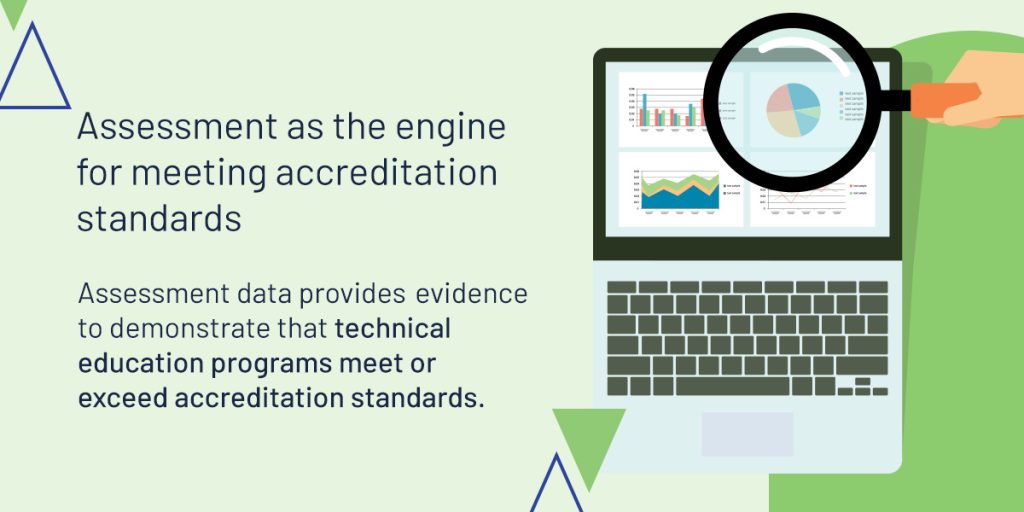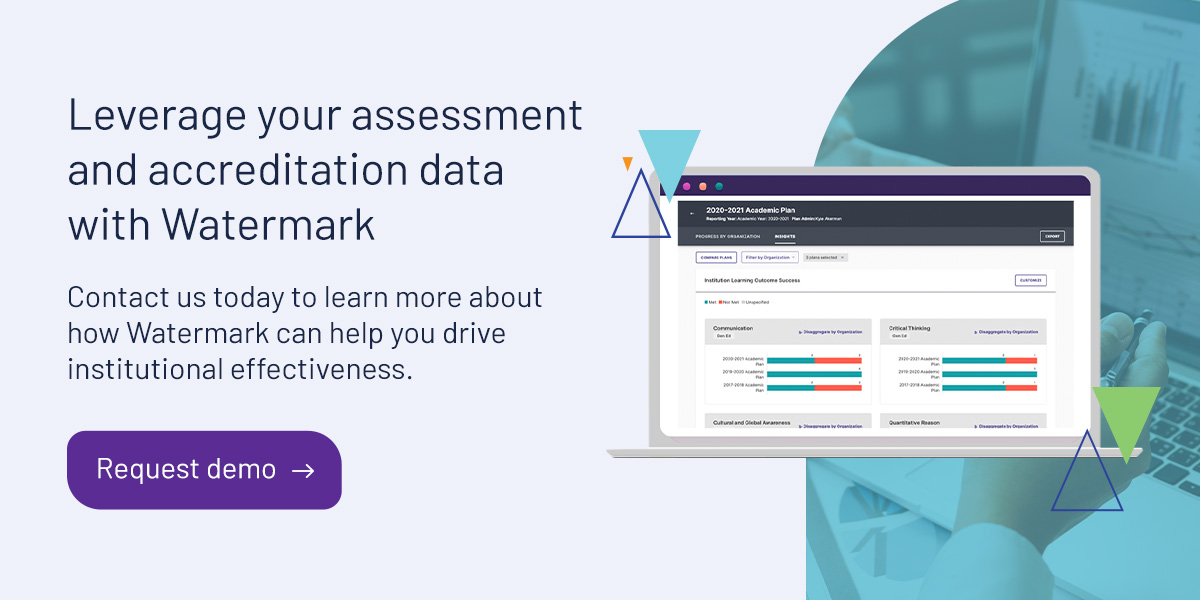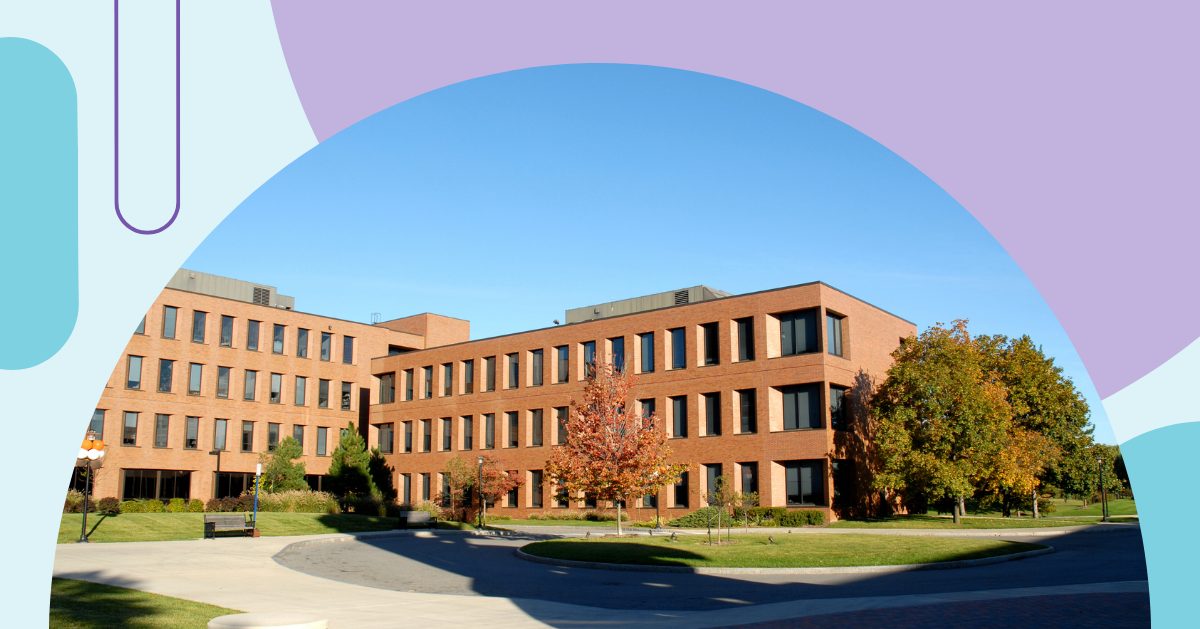
A critical link exists between robust trade school assessment practices and successful accreditation outcomes in technical education. Assessment is the backbone for demonstrating program quality and meeting accreditation standards, but it’s also much more than that. A rise in trade and technical careers means that students and their prospective employers are more discerning. Your institution needs to leverage assessment data effectively to remain competitive.
Teaching, learning, and assessment create an ecosystem of skills, allowing students and faculty to develop professionally. Assessment has always been integral to accreditation and is even more important in today’s changing higher education climate. Instead of merely using it to prove compliance, institutions are creating cultures of assessment, driving continuous improvement, and enhancing the student experience.
An overview of technical education accreditation
Accreditation is a process of external trade education program evaluation by independent parties. These accreditors scrutinize higher education institutions or programs for quality assurance and continuous improvement. If your program is accredited, it provides specific standards of educational quality, faculty expertise, resources, and student support.
Independent agencies conduct the accreditation process to ensure programs meet quality standards, improve institutional credibility, and assist students in choosing reputable programs. They include:
- The Accreditation Board for Engineering and Technology (ABET): As a nonprofit, nongovernmental organization, ABET accredits higher education programs in science, computing, and engineering. An ABET accreditation is widely recognized as the gold standard for engineering and technology programs, making it a sought-after element for employers.
- The Association of Technology, Management, and Applied Engineering (ATMAE): ATMAE is a professional association that accredits technology, management, and applied engineering programs. ATMAE accreditation ensures that graduates of these programs have the skills and knowledge to succeed in technical vocations.
The U.S. Department of Education recognizes these accrediting agencies, allowing students to participate in federal student aid programs. Accreditation for technical education encourages prospective students and their families to trust your programs. While it’s a detailed process, it’s essential for boosting student retention, attracting new students, and adopting a posture of continuous improvement.
The intertwined nature of assessment and accreditation in technical education
Assessment and accreditation requirements are deeply intertwined in higher education, with assessment as the process of evaluating what students get from their chosen technical programs. As accreditation is often a requirement for recognition and legitimacy, it relies on evidence from assessment practices to demonstrate that the program meets the necessary standards. In essence, they complement one another in the following ways.
Accreditation as validation of assessment effectiveness
Accreditation processes inherently evaluate the quality and rigor of your institution’s assessment methods. Institutions need to know how well they prepare students for careers, and their assessment methods should reveal this information. There has been a marked shift from accreditation to a compliance exercise.
Today, it’s a validation of ongoing improvement for institutions — something they can use to adjust and serve the changing needs of students. It’s an ongoing process of self-evaluation, feedback, and improvement. Accreditation shows how your institution’s assessment works and where it can improve.
Assessment as the engine for meeting accreditation standards

In addition to powering your institution’s approach to improving the student experience, assessment practices feed into your broader mission. Assessment data provides evidence to demonstrate that technical education programs meet or exceed accreditation standards. It gives you insights into how well students achieve programmatic goals, which, in turn, fosters a culture of accountability.
The assessment offers actionable insights into student achievement, which informs accreditation. You can only focus on continuous improvement when you know which areas to improve. Assessment gives you the complete picture of your program’s performance, allowing you to make strategic improvements, a key focus of accreditation reviews.
Key assessment areas and their direct impact on trade school accreditation
Most trade and technical programs have clear key assessment areas. Each of these impacts accreditation in the following ways.
Student learning outcomes — the cornerstone of accreditation
At its core, accreditation aims to ensure student success and give access to only the highest-quality education. Students and faculty need a clearly defined end goal. Measurable student learning outcomes are essential for effective assessment and successful accreditation.
Accreditors and employers want to understand how student learning prepares them for the workplace. Aligning learning outcomes with industry standards and employer expectations has never been more critical. Your trade school must use specific assessment methods like capstone projects and simulations to directly demonstrate the achievement of these learning outcomes.
Curriculum mapping — demonstrating alignment and coherence
Curriculum mapping provides a visual representation of the alignment between course content, learning activities, and program learning outcomes. It provides signposts for faculty and administrators that determine the effectiveness of courses in meeting specific learning outcomes. In addition, it demonstrates to accreditors that your institution provides a coherent and well-integrated learning experience.
Faculty qualifications and development — ensuring assessment expertise
Your faculty’s qualifications and ongoing professional development impact the quality of assessment and accreditation. They must be able to demonstrate both alongside their effectiveness in the classroom. Involve your faculty in certification, providing them with training and support in assessment methods and data analysis. The easier they can use assessment results for program improvement, the better they can help your institution meet accreditation criteria.
Leveraging assessment data to tell the accreditation story at your institution
Trade school assessment differs from academic programs in that students must demonstrate technical proficiency alongside theoretical knowledge. Assessment data is increasingly important in achieving this goal. The following tips can help you leverage assessment data to tell the complete story to accreditors:
- Use assessment to demonstrate technical program value: Technical education institutions can move beyond compliance, using assessment data to tell a compelling story about the value and impact of each program. For example, you can use data from capstone projects and simulations to demonstrate how the program prepares students for success in their chosen fields.
- Make assessment data accessible and meaningful: Assessment data is only valuable for accreditation if it’s coherent, accessible, and comprehensive. Store all your data in one place so faculty and staff can use it to continuously improve programs. When accreditors want to view it, it should be coherent, highlighting key findings and trends.
- Communicate results to key stakeholders: While leveraging the immense power of purpose-built data analytics and visualization tools throughout the accreditation process, you must communicate these results to stakeholders efficiently and simply. Analytics and visualization can be used to increase data accessibility and transparency, and these tools will also demonstrate compliance.
Leverage your assessment and accreditation data with Watermark
Assessment and accreditation offer a vital and dynamic relationship that drives technical education. Assessment is a proactive approach to continuous improvement, and with the right data, you can continually enhance your programs to meet evolving student needs. With Watermark Assessment Projects, you can manage student learning at scale and identify improvement opportunities quickly.
Combine the power of this tool with Watermark Planning & Self-Study to get more out of your data. Our software helps you build strong processes, stay agile, and demonstrate progress. Gather and synthesize your data into one centralized location to create actionable insights with our Educational Impact Suite (EIS). Contact us today to learn more about how Watermark can help you drive institutional effectiveness.
















































































































































































































































































































































































































